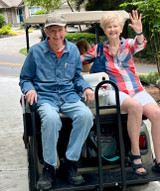For Sale: Madness, Memories, and Maybes
A rummage sale can be defined as a collection of madness, memories and maybes—all “for sale.” It’s a time for restrained grief and grateful hallelujahs. Restrained grief meaning, “I hate to see it go; I’ll miss it.” But, a rejoicing hallelujah that there is now room on the shelf for something more purposeful. It takes days (maybe weeks) to go through the accumulated clutter and decide what you are willing to part with. For Gary and me, it was even more eventful because it was the climax to moving into a smaller home with less storage and my personal vow to de-clutter my life.
Grief is defined as “the loss of something valued.” We don’t often get a choice about grief, but this was a grief I was ready and able to handle. It should be easy, I thought. There should be no emotions to get in the way. I was “giving up” by choice and convenience. What was being taken away had served its purpose. This was not a reaction to crisis, but was voluntary and uneventful. I could do this without tears, without fears and without reservations. After all, it was just “stuff.”
As I began to assemble the potpourri of items, I was enthused because the first mountain of “stuff” was purely madness. It was composed of tablecloths, silk flower arrangements and home décor of every color in the rainbow (depending on which decorating scheme I was emphasizing at the time). As prospective treasure-seekers looked through the items ranging in values from variety store to very nice interior design, I could easily recite the story about the item and the pleasure it gave to me and my home. Each of these items, with their stories, confirmed a purpose in my life.
Kitchen tools and dishware, long crammed into tight storage shelves and drawers, once fueled my obsession with dishes for all seasons and all reasons. The gadgets that make life easier were soon forgotten because I recognized that as a rule, like life, you still had to figure it out for yourself and pick what works best for you.
Young Mennonite women dressed in cotton frocks with white aprons happily scooped up some of these items for their homes. One proclaimed it was her first wedding gift, and since my husband couldn’t find a price sticker, he told her to just take the item.
Small nudges of emotion began to pester me, as I soon realized that every treasure on those tables could be labeled for a particular period of our lives. Selling them was beyond just “stuff”—each one had a story. Each was blanketed with vivid memories. All emotion could not be avoided, it was attached with fine sensitivity to the role these “things” once played in our lives. I didn’t expect that. Rummage sales weren’t about emotion. One shouldn’t grieve the voluntary departure of something once treasured.
I bagged the framed, hand quilted blocks crafted by my grandmother along with the matching pillows. Someone quickly claimed the white hand-croqueted quilt that weighed a ton. Both were irreplaceable items shouting out a legacy of craftsmanship, but now seldom seen.
A selection of Chad’s toys brought sweeping waves of emotion. They reminded me of my loss of dreams. I watched toddlers leaning against an adult with a supportive hand attempting to sit on the floor and play. Young adults (the age of my Chad) picked up the items that brought back a reflection of many happy playtime with memories of their own. The John Deere tractors, the Fisher Price farmyard set that still mooed, Sesame Street finger puppets, and Tinker Toys had been coveted items in years past and most were over thirty years old. They were items a grandchild might have enjoyed.
A tattooed young woman spied Chad’s slicked-up, highly polished, like-new army tanker boots. Managing her telephone camera, she sent pictures to someone describing the unique strapping and “like new” qualities. She wanted approval before she spent $10 on a $200 pair of boots that she was shipping to California to her biker boyfriend. I knew Chad would approve—and chuckle at their destination.
Finally, all the items that sold in the classification of “maybes.” “One man’s trash is another man’s treasure, ”so aptly defined the items once used that now could bring all kinds of possibilities into someone else’s life. I parted with small furniture, lamps, quilts, wall sconce, rugs, framed artwork and curtains. A prospective buyer would pick up the item, turn it around and envision the perfect spot for the abandoned piece.
This gave me a glimpse of hope about a new beginning the item would see. There was a tingling feel of joy that someone else desired an item that I, too, once treasured. My eclectic array of treasures was moving on, given new purpose, new life and new possibilities.
In a world of sadness and grief, hope is the spark of sanity that allows us to look at something differently and imagine the bright spot. Hope allows us to believe that a small change can bring about a miraculous makeover, worthy of the time or few dollars spent. Rummage sales are therapeutic for this.
Rummage sales don’t just weed out the unwanted. They open the closet door to the forgotten, the discarded. They persuade us to unclutter our lives, live more simply, and be grateful for the treasures of the past. They allow us to grieve what we have lost, choose to remember what was important, and commit to valuing what we have left.
Don’t grief and rummage sales then have similar intrinsic values?
• To discard your regrets.
• To confirm that you have lived.
• To savor what you have loved.
• To have enjoyed and to have shared.
• To have brightened lives with cherished memories.
• To ultimately give meaning and purpose to someone else because of your experience.
If parting with personal items and treasures is an act of grief, this was, by far, the easiest moment of grief I’ve ever experienced. It was a perfect rummage sale; one with great rewards; one that will be welcomed again next year, as I continue to walk my path of letting go and living on. A holistic experience of its own kind.
-----------------January 2010
ABOUT THE AUTHOR
“I always wanted to write,” said Nan Zastrow. “But I never dreamed it would be about death, grief and mourning.” Today I write to heal my pain and teach others that even after a life-changing event, there can be a reason and a purpose to go on living.”
On April 16, 1993, Chad Zastrow, the son of Nan and Gary died as the result of suicide. Ten weeks later Chad’s fiancée took her life. This double tragedy inspired the Zastrows to create a ministry of hope. They formed a non-profit organization called Roots© and Wings (Wings™ is a trademark of Roots© and Wings, Ltd.) For ten years, Nan published the Wings magazine for the bereaved and caregivers. In 2004, the Wings organization refocused its efforts as a grief education ministry with the purpose of “Honoring the Past and Rebuilding the Future.”
Through workshops, seminars, group presentations and other methods, Nan and Gary create community awareness about grief experiences. Additionally, they host an annual Spring Seminar and Holiday workshop. As the result of five sudden deaths of significant people in their lives, they facilitate a Sudden Death Learning Series. In 2004, they also offered “What Next?” (a hands-on series for the bereaved who are ready to move forward and find meaning and purpose after loss.)




